The Evolution of Wearable Technology in the United States
Pioneering Innovations: The History of Fila Watches
Fila, a renowned sports brand, entered the watch market with style and innovation. Their journey began in the 1980s, focusing on sporty designs. Fila watches quickly gained popularity among athletes and fashion enthusiasts alike. They offered durability and functionality at affordable prices. Over time, Fila expanded its range to include more sophisticated models. These watches combined classic timekeeping with modern aesthetics. Fila's commitment to quality and style helped them carve a niche in the market. Their watches became synonymous with active lifestyles and urban fashion. As technology advanced, Fila adapted, incorporating new features into their designs. This evolution set the stage for the brand's continued relevance in the changing landscape of wearable tech.

From Basic Timepieces to Smartwatches: Technological Advancements
The transition from basic watches to smartwatches marks a significant leap in wearable tech. Early digital watches introduced features like calculators and alarms. These were the first steps towards multifunctional wrist devices. The late 1990s saw the emergence of early smartwatch concepts. However, it wasn't until the 2010s that smartwatches gained mainstream attention. The introduction of Apple Watch in 2015 was a game-changer. It brought advanced features like health tracking and mobile connectivity to the wrist. Other tech giants soon followed, expanding the smartwatch market. These devices now offer features like GPS, heart rate monitoring, and smartphone notifications. The rapid evolution of smartwatches has redefined our interaction with technology. They've transformed from simple timekeeping devices to powerful wearable computers.
Comparing Fila Watches with Smartwatches: Features and Functions
Diving into the Differences: Smartwatches vs. Traditional Watches
Fila watches and smartwatches serve different purposes and cater to varied needs. Fila watches excel in simplicity and reliability. They offer accurate timekeeping without the need for frequent charging. Most Fila watches are water-resistant and durable, ideal for sports and outdoor activities. Their designs often focus on style and comfort, with a wide range of looks. In contrast, smartwatches are tech powerhouses on your wrist. They offer features like fitness tracking, heart rate monitoring, and GPS. Smartwatches can display notifications, make calls, and even run apps. However, they require regular charging and updates. The choice between the two depends on individual needs and preferences. Some prefer the simplicity of Fila watches, while others need the advanced features of smartwatches.

The Intersection of Fashion and Functionality in Wearable Tech
Both Fila watches and smartwatches strive to balance fashion with functionality. Fila watches often feature sleek designs that complement various styles. They offer a range of colors and materials to suit different tastes. Many Fila watches are suitable for both casual and formal wear. Smartwatches, initially criticized for their tech-heavy looks, have evolved. Many now offer customizable faces and interchangeable bands. This allows users to personalize their devices to match their style. High-end smartwatches even collaborate with fashion brands. This fusion of technology and fashion appeals to a broader audience. It bridges the gap between tech enthusiasts and fashion-conscious consumers. The challenge lies in creating devices that are both stylish and highly functional.
Implications for Consumers and Market Trends
Understanding the Target Demographics for Fila Watches and Smartwatches
Fila watches and smartwatches appeal to different consumer groups. Fila watches typically attract sports enthusiasts and fashion-conscious individuals. Their affordability makes them popular among younger consumers and budget-conscious buyers. Many appreciate Fila watches for their reliability and low maintenance. Smartwatches, on the other hand, often target tech-savvy consumers. They appeal to fitness enthusiasts who value detailed health tracking. Professionals who need constant connectivity also gravitate towards smartwatches. The higher price point of smartwatches attracts middle to high-income consumers. Age-wise, smartwatches are popular among millennials and Gen Z. However, their adoption is increasing across all age groups. Understanding these demographics helps brands tailor their products and marketing strategies.

Future Prospects: What the Future Holds for Wearable Technology
The future of wearable technology looks promising and diverse. Smartwatches are likely to become more advanced and health-focused. We may see improved sensors for monitoring various health metrics. AI integration could provide more personalized insights and recommendations. Traditional watch brands like Fila might incorporate smart features into their designs. This could lead to hybrid watches that blend classic style with modern tech. The line between smartwatches and traditional watches may blur further. We might see more emphasis on battery life and durability in future smartwatches. Privacy and data security will become increasingly important in wearable tech. The market may also expand to include new forms of wearable devices. Overall, the wearable technology sector is poised for continued growth and innovation.




Leave a comment
This site is protected by hCaptcha and the hCaptcha Privacy Policy and Terms of Service apply.